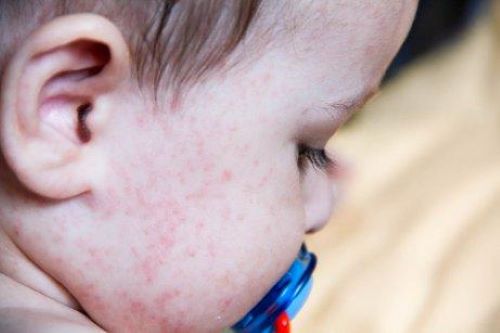Allergies to Latex in Children: Know the Symptoms

Some children are sensitive to the products that are made with natural latex and develop allergies to latex. The reactions are caused by exposure to the proteins of the rubber tree that go into making latex.
In fact, some people aren’t allergic to the latex itself, rather to the synthetic chemical products that are found in natural latex products.
In general, there are some children that have a greater propensity than others to become sensitive to latex. This is the case for those who were born with abnormalities of the urinary system, those with spina bifida, or those who have undergone a lot of surgeries.
Children who have allergies to certain foods can also be allergic to latex. This is because these foods and the element in latex they’re allergic to share some proteins in common. The following are some of the foods that contain the same proteins as latex:
- Kiwi
- Bananas
- Nectarines
- Melon
- Papaya
- Figs
- Plums
- Tomatoes
- Celery
- Nuts
- Chesnuts
- Avocado
- Potatoes
Additionally, the symptoms of a latex allergy cover just about the entire range of hypersensitive reactions.
Respiratory problems are common because of the dust that covers the inside of latex gloves. The particles of latex are transported in the air thus producing respiratory symptoms for some patients.
The irritation from latex manifests either alone or in combination with a runny nose, conjunctivitis, difficulties breathing, or an asthma attack. It can also cause a cutaneous reaction that is potentially serious called urticaria.

Allergies to latex in children
Natural rubber latex is a milky liquid that comes from rubber trees. It’s composed of a protein that causes allergic reactions. This element is in different types of gloves, balloons, glues, adhesives, and erasers. Also, many toys contain natural rubber latex.
You should know there is no cure for an allergy to latex in children; the best course is to avoid exposure. Nonetheless, there are medications that temporarily reduce the symptoms.
In respect to the symptoms children may experience due to this allergic reaction, the effects can take several hours to develop. In other cases, the symptoms may sometimes manifest immediately and even cause serious reactions.
Children who are at risk for latex allergies should visit an allergy specialist for an evaluation. The skin prick test is a very effective analysis that identifies patients who are potentially allergic to specific substances.
With additional skin tests, it’s possible to discover if the patient is allergic to the synthetic chemical substances that many rubber products contain.
Moreover, children who are allergic to latex should wear a medic alert bracelet to let caregivers, including dentists, doctors, nurses, teachers, friends, and family members know they’re sensitive to these substances.
What are the symptoms of a latex allergy?
In most cases, a latex allergy develops after coming into contact with latex many times previously. When a child who is allergic to latex comes into contact with products that contain latex, he or she may experience the following symptoms:
- Urticaria.
- Irritation and swelling of the skin.
- Redness.
- Rashes.
- Wheezing.
However, in some cases, the allergy can cause serious reactions, where the child can have problems breathing, tightness in the chest or swelling of the throat or tongue. These severe reactions require emergency treatment.
Managing latex allergies
It’s for this reason that people who are allergic to latex should let staff know about their condition before they undergo any medical procedure that involves the use of gloves.

It should also be noted that it’s not necessary to come into direct physical contact with latex to cause an allergic reaction.
Severe asthma reactions can arise from inhaling the proteins in the dust inside latex gloves. It’s easy for the dust to spread through the air as doctors and nurses frequently change their gloves.
In the same way, children can have reactions if products made with latex come into contact with their skin, whether it be the mucus membranes of the mouth, the genitals, or the rectum.
In this light, studies associate latex allergies in children with a family history of sensitivity and a history of prior surgeries.
Finally, don’t forget that the symptoms of this type of allergic reaction can seem like other medical conditions. For that reason, you should always consult your child’s doctor so they can make a diagnosis.
Moreover, you need to teach your children to recognize products that contain latex and avoid them because they may cause an allergic reaction.
Some children are sensitive to the products that are made with natural latex and develop allergies to latex. The reactions are caused by exposure to the proteins of the rubber tree that go into making latex.
In fact, some people aren’t allergic to the latex itself, rather to the synthetic chemical products that are found in natural latex products.
In general, there are some children that have a greater propensity than others to become sensitive to latex. This is the case for those who were born with abnormalities of the urinary system, those with spina bifida, or those who have undergone a lot of surgeries.
Children who have allergies to certain foods can also be allergic to latex. This is because these foods and the element in latex they’re allergic to share some proteins in common. The following are some of the foods that contain the same proteins as latex:
- Kiwi
- Bananas
- Nectarines
- Melon
- Papaya
- Figs
- Plums
- Tomatoes
- Celery
- Nuts
- Chesnuts
- Avocado
- Potatoes
Additionally, the symptoms of a latex allergy cover just about the entire range of hypersensitive reactions.
Respiratory problems are common because of the dust that covers the inside of latex gloves. The particles of latex are transported in the air thus producing respiratory symptoms for some patients.
The irritation from latex manifests either alone or in combination with a runny nose, conjunctivitis, difficulties breathing, or an asthma attack. It can also cause a cutaneous reaction that is potentially serious called urticaria.

Allergies to latex in children
Natural rubber latex is a milky liquid that comes from rubber trees. It’s composed of a protein that causes allergic reactions. This element is in different types of gloves, balloons, glues, adhesives, and erasers. Also, many toys contain natural rubber latex.
You should know there is no cure for an allergy to latex in children; the best course is to avoid exposure. Nonetheless, there are medications that temporarily reduce the symptoms.
In respect to the symptoms children may experience due to this allergic reaction, the effects can take several hours to develop. In other cases, the symptoms may sometimes manifest immediately and even cause serious reactions.
Children who are at risk for latex allergies should visit an allergy specialist for an evaluation. The skin prick test is a very effective analysis that identifies patients who are potentially allergic to specific substances.
With additional skin tests, it’s possible to discover if the patient is allergic to the synthetic chemical substances that many rubber products contain.
Moreover, children who are allergic to latex should wear a medic alert bracelet to let caregivers, including dentists, doctors, nurses, teachers, friends, and family members know they’re sensitive to these substances.
What are the symptoms of a latex allergy?
In most cases, a latex allergy develops after coming into contact with latex many times previously. When a child who is allergic to latex comes into contact with products that contain latex, he or she may experience the following symptoms:
- Urticaria.
- Irritation and swelling of the skin.
- Redness.
- Rashes.
- Wheezing.
However, in some cases, the allergy can cause serious reactions, where the child can have problems breathing, tightness in the chest or swelling of the throat or tongue. These severe reactions require emergency treatment.
Managing latex allergies
It’s for this reason that people who are allergic to latex should let staff know about their condition before they undergo any medical procedure that involves the use of gloves.

It should also be noted that it’s not necessary to come into direct physical contact with latex to cause an allergic reaction.
Severe asthma reactions can arise from inhaling the proteins in the dust inside latex gloves. It’s easy for the dust to spread through the air as doctors and nurses frequently change their gloves.
In the same way, children can have reactions if products made with latex come into contact with their skin, whether it be the mucus membranes of the mouth, the genitals, or the rectum.
In this light, studies associate latex allergies in children with a family history of sensitivity and a history of prior surgeries.
Finally, don’t forget that the symptoms of this type of allergic reaction can seem like other medical conditions. For that reason, you should always consult your child’s doctor so they can make a diagnosis.
Moreover, you need to teach your children to recognize products that contain latex and avoid them because they may cause an allergic reaction.
This text is provided for informational purposes only and does not replace consultation with a professional. If in doubt, consult your specialist.








